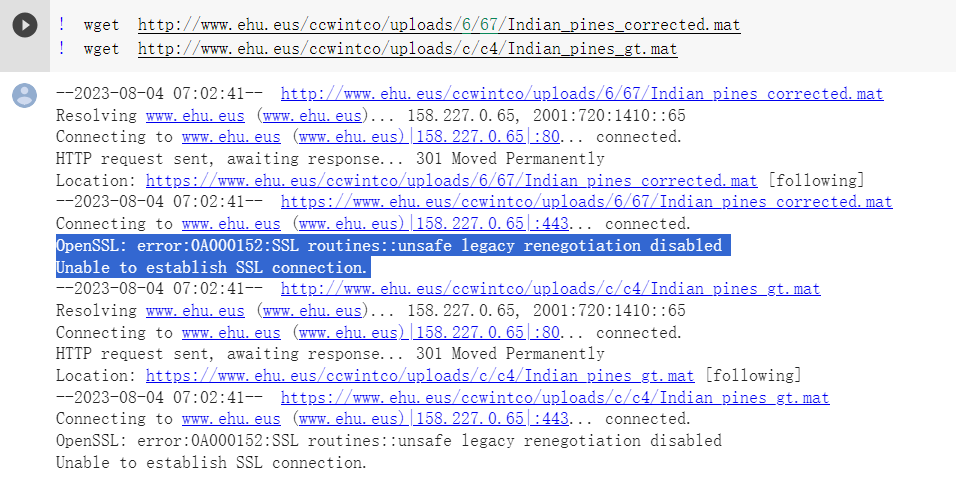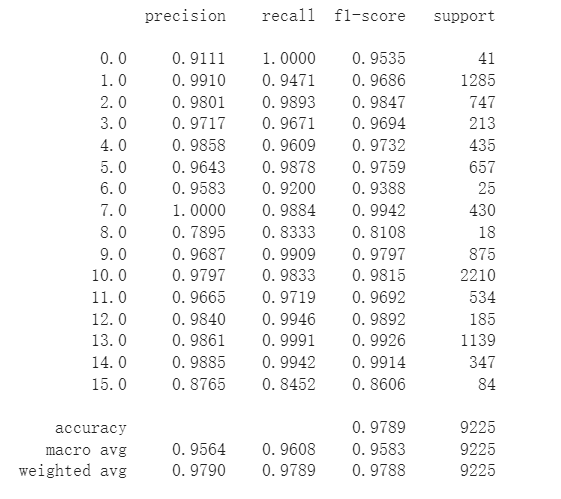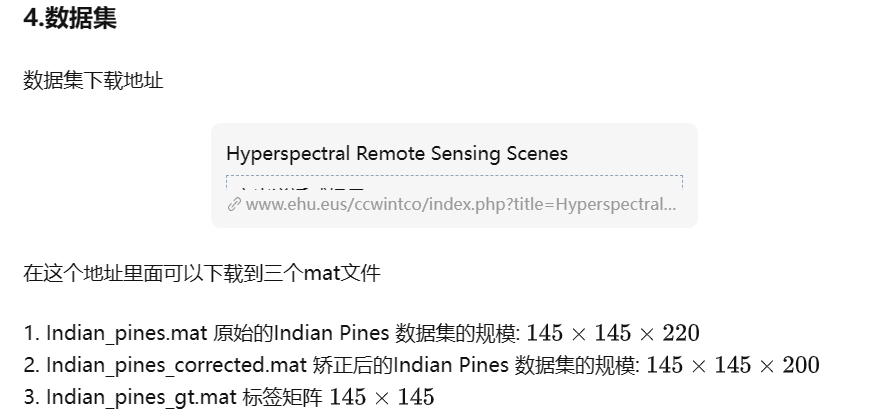报错:unsafe legacy renegotiation disabled

解决方案:
尝试了更换cryptography==36.0.2版本,以及更换下载链接的方法,都不行,最后采用了手动下载mat文件并上传到colab的方法
高光谱图像分类数据集简介Indian Pines&mat
定义网络:

class HybridSN(nn.Module):def __init__(self):super(HybridSN, self).__init__()self.conv3d_1 = nn.Sequential(nn.Conv3d(1, 8, kernel_size=(7, 3, 3), stride=1, padding=0),nn.BatchNorm3d(8),nn.ReLU(inplace = True),)self.conv3d_2 = nn.Sequential(nn.Conv3d(8, 16, kernel_size=(5, 3, 3), stride=1, padding=0),nn.BatchNorm3d(16),nn.ReLU(inplace = True),) self.conv3d_3 = nn.Sequential(nn.Conv3d(16, 32, kernel_size=(3, 3, 3), stride=1, padding=0),nn.BatchNorm3d(32),nn.ReLU(inplace = True))self.conv2d_4 = nn.Sequential(nn.Conv2d(576, 64, kernel_size=(3, 3), stride=1, padding=0),nn.BatchNorm2d(64),nn.ReLU(inplace = True),)self.fc1 = nn.Linear(18496,256)self.fc2 = nn.Linear(256,128)self.fc3 = nn.Linear(128,16)self.dropout = nn.Dropout(p = 0.4)def forward(self,x):out = self.conv3d_1(x)out = self.conv3d_2(out)out = self.conv3d_3(out)out = self.conv2d_4(out.reshape(out.shape[0],-1,19,19))out = out.reshape(out.shape[0],-1)out = F.relu(self.dropout(self.fc1(out)))out = F.relu(self.dropout(self.fc2(out)))out = self.fc3(out)return out
实验结果:

本次准确率为97.89%
思考题
● 训练HybridSN,然后多测试几次,会发现每次分类的结果都不一样,请思考为什么?
每次训练的时候,神经网络的参数和权重都是随机的,所以每次的结果都不一样。
● 如果想要进一步提升高光谱图像的分类性能,可以如何改进?
增加注意力机制,把Attention加在第三个三维卷积后,以保留更多的光谱信息,从而进一步提升高光谱图像的分类性能。
● depth-wise conv 和 分组卷积有什么区别与联系?
Depth-wise conv(深度可分离卷积)和分组卷积是两种用于减少卷积计算量的优化技术。区别在于:
- Depth-wise conv是在每个输入通道上独立地进行卷积操作,然后再将结果在通道维度上进行组合。这样可以减少参数数量和计算量,但每个通道之间没有交互信息。
- 分组卷积是将输入通道分为若干组,然后在每组内进行卷积操作。这样可以在一定程度上减少计算量,并且每组内的通道可以相互交互信息。但相比普通卷积,分组卷积可能引入一定的信息损失。
● SENet 的注意力是不是可以加在空间位置上?
SENet的注意力机制主要是通过学习通道之间的关系来提升特征的重要性,但也可以通过适当的调整将注意力扩展到空间位置上,从而使网络能够关注不同空间位置上的特征,进一步提升性能。
● 在 ShuffleNet 中,通道的 shuffle 如何用代码实现?
import torchdef channel_shuffle(x, groups):batch_size, height, width, channels = x.size()channels_per_group = channels // groups# Reshape the tensor to (batch_size, height, width, groups, channels_per_group)x = x.view(batch_size, height, width, groups, channels_per_group)# Transpose the tensor along the last two dimensions (swap channels_per_group and groups)x = x.permute(0, 1, 2, 4, 3)# Reshape the tensor back to its original shapex = x.view(batch_size, height, width, channels)return x










)





:数据结构)


)
